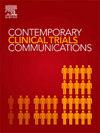评估三维窗口双屏(3D- wds)在坦桑尼亚东北部减少疟疾传播方面的功效:一项两组随机对照试验的研究方案
IF 1.4
Q4 MEDICINE, RESEARCH & EXPERIMENTAL
引用次数: 0
摘要
疟疾病媒中杀虫剂耐药性的上升突出表明迫切需要不依赖杀虫剂的替代病媒控制方法。3D- screen是一种创新的窗纱,将3D圆锥形结构集成到网格中,提供了一个很有前途的解决方案。当在窗户开口安装双纱窗装置(3D-Window Double Screen,或3D-WDS)时,其单向设计允许蚊子从生活区的外部或内部进入纱窗之间的空间,有效地将它们困在围栏内。先前的实验室和实验小屋研究已经证明3D-WDS在捕获寻找宿主的蚊子方面具有很高的功效。本研究旨在评估在社区环境中实施3d屏幕的流行病学、昆虫学和社会影响。方法/设计进行了一项双臂、集群随机对照试验(cRCT),以评估同时配备3D-WDS和长效杀虫蚊帐(LLINs)的家庭是否比单独配备长效杀虫蚊帐的家庭提供了更强的疟疾防护。对坦桑尼亚Muheza 17个村庄的20个村庄的疟疾流行率、媒介密度、昆虫接种率和杀虫剂抗性水平进行了评估。然后随机分配14个具有相似流行病学和昆虫学特征的村庄:7个被分配到干预组(3D-WDS + LLINs), 7个作为对照组(仅LLINs)。在52周的随访期内,每隔10周进行流行病学和昆虫学监测。进行了辅助的社会科学研究,以评估社区对3D-WDS干预的看法,重点是可接受性和影响其可持续性的因素。统计分析将使用混合效应模型来比较3D-WDS联合LLINs与单独使用LLINs的影响。3D-WDS有可能通过提供一种非杀虫的、可持续的蚊虫控制方法来减少疟疾传播。这项试验的结果将证明其在现实世界中的有效性,并有助于制定可扩展的长期疟疾预防战略。试验注册isrctn注册中心,ISRCTN87169034。该研究于2019年6月启动,于2021年6月完成招募和抽样,正在进行样本分析和统计评估。本文章由计算机程序翻译,如有差异,请以英文原文为准。
Assessing the efficacy of 3D window double screens (3D-WDS) in reducing malaria transmission in northeastern Tanzania: Study protocol for a two-arm cluster-randomised controlled trial
Background
The rise of insecticide resistance in malaria vectors has highlighted the urgent need for alternative vector control methods that do not rely on insecticides. The 3D-Screen, an innovative window screen featuring 3D conical structures integrated into a mesh, offers a promising solution. When installed as a double-screen setup (3D-Window Double Screen, or 3D-WDS) in window openings, its unidirectional design allows mosquitoes to enter the space between the screens from either the outside or inside of the living area, effectively trapping them within the enclosure. Previous laboratory and experimental hut studies have demonstrated the high efficacy of 3D-WDS in capturing host-seeking mosquitoes. This study aims to evaluate the epidemiological, entomological, and social impacts of implementing 3D-Screens in community settings.
Methods/design
A two-arm, cluster-randomised controlled trial (cRCT) was conducted to assess whether houses equipped with both 3D-WDS and long-lasting insecticidal nets (LLINs) provide enhanced protection against malaria compared to LLINs alone. Twenty hamlets across 17 villages in Muheza, Tanzania, were evaluated for malaria prevalence, vector densities, entomological inoculation rates, and insecticide resistance levels. Fourteen hamlets with similar epidemiological and entomological profiles were then randomised: seven were assigned to the intervention group (3D-WDS + LLINs), and seven served as the control group (LLINs alone). Epidemiological and entomological surveillance were conducted at 10-week intervals over a 52-week follow-up period. Ancillary social science studies were conducted to assess community perceptions of the 3D-WDS intervention, focusing on acceptability and factors influencing its sustainability. Statistical analyses will use mixed-effects models to compare the impact of 3D-WDS combined with LLINs versus LLINs alone.
Discussion
The 3D-WDS has the potential to reduce malaria transmission by providing a non-insecticidal, sustainable approach to mosquito control. Findings from this trial will demonstrate its real-world effectiveness and contribute to the development of scalable, long-term strategies for malaria prevention.
Trial registration
ISRCTN Registry, ISRCTN87169034.
Trial status
The study was initiated in June 2019, recruitment and sampling were completed in June 2021, sample analyses, and statistical evaluations are ongoing.
求助全文
通过发布文献求助,成功后即可免费获取论文全文。
去求助
来源期刊

Contemporary Clinical Trials Communications
Pharmacology, Toxicology and Pharmaceutics-Pharmacology
CiteScore
2.70
自引率
6.70%
发文量
146
审稿时长
20 weeks
期刊介绍:
Contemporary Clinical Trials Communications is an international peer reviewed open access journal that publishes articles pertaining to all aspects of clinical trials, including, but not limited to, design, conduct, analysis, regulation and ethics. Manuscripts submitted should appeal to a readership drawn from a wide range of disciplines including medicine, life science, pharmaceutical science, biostatistics, epidemiology, computer science, management science, behavioral science, and bioethics. Contemporary Clinical Trials Communications is unique in that it is outside the confines of disease specifications, and it strives to increase the transparency of medical research and reduce publication bias by publishing scientifically valid original research findings irrespective of their perceived importance, significance or impact. Both randomized and non-randomized trials are within the scope of the Journal. Some common topics include trial design rationale and methods, operational methodologies and challenges, and positive and negative trial results. In addition to original research, the Journal also welcomes other types of communications including, but are not limited to, methodology reviews, perspectives and discussions. Through timely dissemination of advances in clinical trials, the goal of Contemporary Clinical Trials Communications is to serve as a platform to enhance the communication and collaboration within the global clinical trials community that ultimately advances this field of research for the benefit of patients.
 求助内容:
求助内容: 应助结果提醒方式:
应助结果提醒方式:


